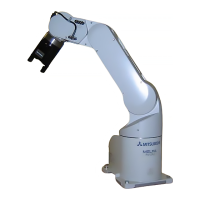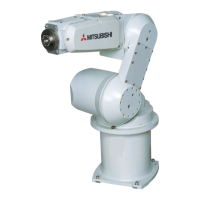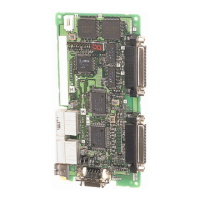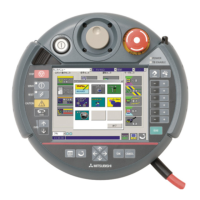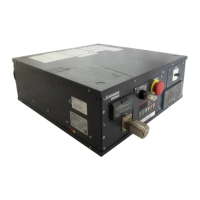6Safety
Working environment 6-125
6.2 Working environment
Avoid installation in the following places as the equipment's life and operation will be affected by the ambient
environment conditions. When using in the following conditions, the customer must pay special attention to the
preventive measures.
(1) Power supply
・ Where the voltage fluctuation will exceed the input voltage range.
・ Where a momentary power failure exceeding 20ms may occur.
・ Where the power capacity cannot be sufficiently secured.
Please use the controller with an input power supply voltage fluctuation rate of 10% or
less. In the case of 200 VAC input, for example, if the controller is used with 180 VAC
during the day and 220 VAC during the night, turn the servo off once and then on again.
If this is not performed, an excessive regeneration error may occur.
(2) Noise
・ Where a surge voltage exceeding 1000V, 1μs may be applied on the primary voltage. Near large inverters, high
output frequency oscillator, large contactors and welding machines. Static noise may enter the lines when this
product is used near radios or televisions. Keep the robot away from these items.
(3) Temperature and humidity
・ Where the atmospheric temperature exceeds 40 degree , lower than 0 degree.
・ Where the relative humidity exceeds 85%, lower than 45%, and where dew may condense.
・ Where the robot will be subject to direct sunlight or near heat generating sources such as heaters.
(4) Vibration
・ Where excessive vibration or impact may be applied. (Use in an environment of 34m/s
2
or less during transpor
-
tation and 5m/s
2
or less during operation.)
(5) Installation environment
・ Where strong electric fields or magnetic fields are generated.
・ Where the installation surface is rough. (Avoid installing the robot on a bumpy or inclined floor.)
・ Where there is heavy powder dust and oil mist present.
6.3 Precautions for handling
(1) RV-2F series robot has brakes on J2, J3 and J5 axes. And RV-2FB series robot has brakes on all axes. The
precision of the robot may drop, looseness may occur and the reduction gears may be damaged if the robot is
moved with force with the brakes applied. Moreover, when the axis without the brake is servo-off, take care to
falling by the self-weight.
(2) Avoid moving the robot arm by hand. When unavoidable, gradually move the arm. If moved suddenly, the accu
-
racy may drop due to an excessive backlash, or the backed up data may be destroyed.
(3) Note that depending on the posture, even when within the movement range, the wrist section could interfere
with the base section. Take care to prevent interference during jog.
*1)
(4) The robot arm is configured of precision parts such as bearings. Grease is used for lubricating these parts.
When cold starting at low temperatures or starting operation after long-term stoppage, the position accuracy
may drop or servo alarms may occur. If these problems occur, perform a 5 to 10 minute running-in operation at
a low speed (about a half of normal operating speed).
(5) The robot arm and controller must be grounded with 100Ω or less (class D grounding) to secure the noise
resistance and to prevent electric shocks.
(6) The items described in these specifications are conditions for carrying out the periodic maintenance and
inspections described in the instruction manual.
*1) Jog operation refers to operating the robot manually using the teaching pendant.
CAUTION
